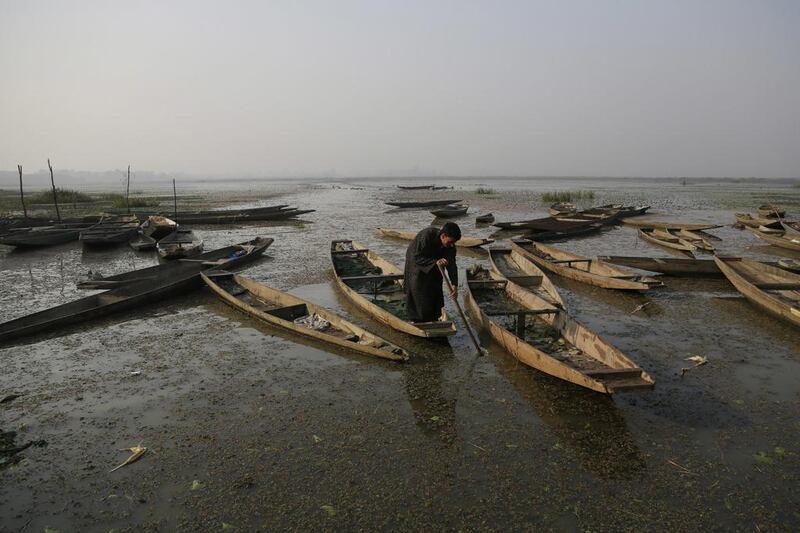WULAR LAKE, India // Tucked within Kashmir’s Himalayan foothills sits a freshwater lake that was once among Asia’s largest. Long an inspiration to poets, beloved by kings, Wular Lake has been reduced in places to a fetid and stinking swamp.
Just the sight of it makes Mohammed Subhan Dar feel sick. He admits he is partly responsible.
Mr Dar was among dozens of villagers employed in the 1950s by the regional government to plant millions of water-sucking willows in the crystalline lake. The goal had been to create vast plantations for growing firewood and timber for construction and cricket bats. The result was the accidental near-destruction of the lake, as trees drank from its waters and their tangled roots captured soil, building up land.
The lake, now less than half of its former capacity, no longer churns and heaves with high waves, but meanders across mossy swamps and trash-strewn backwaters. Children long ago stopped playing in the water. Families no longer use it to cook.
“It used to be so beautiful, so clear you could see the bottom,” said Mr Dar, whose family has lived lakeside for seven generations. Needing a job, he alone planted at least a hectare of what is now a full-blown willow forest. “I feel ashamed every day.”
As Wular lost its appeal, its value declined. Poverty rates in the 31 surrounding villages shot up to around 50 per cent – five times the state average.
Kashmir and New Delhi officials now want to repair some of the damage by felling millions of trees and dredging parts of the lake. But restoring an enormous alpine lake is no simple thing, especially with climate change threatening the Himalayan glaciers that feed Wular’s waters, and deforestation still unleashing soil to again clog it up.
Restoring a lake in Indian-controlled Kashmir, where a decades-long violent conflict often supersedes all other government plans, may be near impossible.
Wular’s surface lies flat, lifeless and in some spots stagnant, teeming with mosquitoes. The water trickles in from the Jhelum River, and meanders some 16 kilometres before emptying through a dam on its way toward Pakistan.
The name Wular itself means “stormy” in the Kashmiri language, and once described the lake’s strong winds and choppy waters. For centuries, it was considered a paradise by writers, nobles and travellers who camped along its banks.
Mohammed Azim Tuman remembers a boyhood spent steering his houseboat by moonlight over towering waves.
“My heart would be racing as I clung to the railing to keep from falling into the water,” said Tuman, the elderly proprietor of a tourism business. “When a storm hit, the water would splash so high I thought, ‘My god, the boat will be swallowed whole.”’
The surface and surrounding marshlands have shrunk from 216 square kilometres in 1911 to just 104 sq km in 2008.
Along the fringes, impoverished communities tend rice paddies and in autumn harvest wild water chestnuts from the lake shallows.
The ornately carved wooden houseboats that once surfed Wular’s waves are gone.
“It’s typical throughout India, not just in Kashmir. The critical balance between ecology and economy that is missed,” said Anzar A. Khuroo, assistant professor of biodiversity at the University of Kashmir in Srinagar.
Since 1990, the planet has lost 75 per cent of its wetlands as communities drained the water and built on the land. That often comes with economic losses, because wetlands provide services including water filtration, flood control and wildlife support.
In 2008, Wetlands International came out with an US$82 million (Dh300m) plan to restore Wular’s ecology, estimating the costs could recouped within 12 years from timber profits, improved fish stocks and an expected 40 per cent boom in eco-tourism.
The Indian government was intrigued. Some experts suggested it could be done more cheaply.
In 2011, India’s parliament approved a $26m budget. Officials began talking about water sports, five-star hotels and riverside parks.
If only it had been so easy. A host of players needed to get on board: individuals, villages and several state government bodies including forestry, farming, fisheries, pollution control and the army.
It took years just for them to agree on the lake’s boundaries. The project was again re-evaluated. The budget dropped to $2m.
By the time the first willows were chopped down, it was 2015. Only half the budget was allocated, and those in charge knew it was not enough.
Still, they chopped and dredged. They removed about a million cubic meters of silt — or 200,000 truckloads — before federal funding expired.
Whether the project can survive now is debatable. Any further work will need a new proposal, environmental assessment and much more money. The programme’s manager Rashid Naqash estimates it’ll cost about $280m.
Yet the willows are not the only problem. Lake-clogging soil and silts are being loosed from newly deforested lands far upstream, and scientists also warn that climate change is upsetting Himalayan rainfall patterns.
“I don’t think the government has an understanding of how difficult this work would be,” said Himalayan geologist and glaciologist Shakil Romshoo.
*Associated Press





